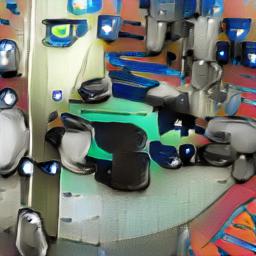
Introduction
Contrary to modern-day humanist conceptions of the human, which are considered to be burdened with eurocentric, racist, sexist, and speciesist prejudices that are rooted in power and control (Diéguez, 2017), the aim of posthumanism is to put an end to dichotomies that separate individuals and subjects from everything that surrounds them: other humans, non-human elements, and the universe in general. So, like spiritual perspectives—in particular, Eastern ones—posthumanism is a system of thought based on the essential interconnectedness of existence, and censures any exclusive anthropocentric posture which fails to root humans in their environment (Ferrando, 2016).
The posthumanist view therefore dispenses with a number of culturally-constructed dichotomies such as natural/artificial, mind/body, and organism/machine. These three dichotomies, nevertheless, do allow us to analyse the ideological and symbolic management of body and mind—seen here as integrated—in the practice and experience of religion, which is particularly relevant for the relationship between posthumanism and spirituality.
Furthermore, religions have always dealt with the problem of death. In this respect, the promise of transhumanism and posthumanism is that in the near future we will be able to delay death, or even eliminate it altogether through so-called disembodied consciousness or cryogenesis. Some spiritual systems, such as Tantric Buddhism, view immortality in a similar way, considering the mind/consciousness to be eternal, as opposed to the body, which is its temporary home. Or to put it another way: the mind is the driver and the body the vehicle. In the same way, the transhumanist perspective suggests that the machine can become the new vehicle of the mind, making it eternal. If the brain can be synthesised and removed from the biological body, it is perfectly replicable in an intelligent machine or cyborg.
Despite the postmodern tendency towards the absence of corporeality (“Sanex bodies do not smell; Danone bodies are untouchable”, Lucerga 2004), the material body does continue to have an intrinsic value, because, in accordance with the important posthumanist concept of agency, it predisposes subjects to action and stimulates their interaction with other human beings and non-human beings such as the sacred objects and deities of any religious pantheon.
Moreover, the body is an ideal field for both scientific and spiritual experimentation, and can be subjected to a number of human interventions or practices that seek to improve it, from bionic implants and genetic modifications to the discipline of yoga. After all, the body is a religious symbol par excellence, and in posthumanism, as in most spiritual systems, it is an experiential vehicle which enables us to exist in and interact with both natural and artificial worlds (Chelín; Mellor, 2007).
According to transhumanist criteria, in fact, the body emerges as part of the search for salvation and transcendence. And as in many fields of spirituality, it is inseparable from mental and cerebral processes. Taming the body and pacifying the mind are processes that are part of many religions, executed either by means of technologies such as meditation or other technological approaches associated with the digital or computational world.
1
One of the effects of the relocation and restructuring of religions in 21st century society is the phenomenon of so-called cyber-religions and techno-religions, which, along highly posthuman lines, promote plurality and subjectivity, largely thanks to the interactive participation made possible by technology (Lyon, 2002).
In response to the wide range of contemporary frustrations, there appears to be a reactivation of religious sentiment, or, at least, a greater acceptance of the supernatural, the esoteric, and the mysterious, in all their different manifestations. Perhaps because of this, “the ideology of the new postmodern and posthuman times stimulates the abandonment of strict rationality, weakening the frontier between facts and values, between the affective and the cognitive, and between the real and the virtual” (Ibáñez, 2014: 109).
Within this context, the aim of posthumanism is to displace the idea of an autonomous rational subject. Instead, it emphasises that human beings are involved in ongoing interconnections, causalities, and interdependencies. The beliefs that human beings are part of the world but are not the centre of the world and that they are linked to everything around them (human or not) are shared by a number of holistic and spiritual perspectives.


2
The most diverse spiritual and religious aspirations revolve around enhancing and improving the capacities of human beings, both in terms of their nature and identity and in relation to their surroundings. Self-improvement through religious devotion and practice is often seen in ethical, cognitive, and behavioural terms, as well as in relation to consciousness. The body and mind thus play a critical role in the dynamics of change and progress towards personal transformation, transcendence and the attainment of a perfect and absolute ideal.
Existential change and personal transformation is inherent to spiritual practices, many of which, in a somewhat postmodern sense, appeal to shifts of state, to the transience of material things, and to the relativism of hegemonic realities and non-religious discourses. They often rely, however, on the more or less dogmatic certainty of ultimate fulfilment, a belief that could be described as posthuman.
Buddhists, transhumanists, and posthumanists all believe that human beings have the potential to take advantage of the synergies of change—including scientific and technological change—in order to direct their evolutionary progress without impediment or limit.


3
Just as religion and healthcare—or therapeutic processes—always go hand in hand, transhumanists and posthumanists are also very concerned with prolonging life, maximising well-being, and minimising the negative effects of ageing. This leads them to propose healthy habits and techniques to keep the body in good form, such as exercise, a good diet, surgery, and the consumption of vitamins.
Care and knowledge of one’s body and mind, especially with the aim of putting an end to suffering, are key aspects in the field of spirituality, especially within the broad orbit of New Age thinking. Along with the biotechnologies so highly valued by posthumanism, neuroscience enables a comprehensive study of the brain and neural processes, which, for example, can help us to understand how great meditators succeed in purifying and calming their minds when in search of spiritual enlightenment.
Systems such as Buddhism or Scientology ultimately operate as psychotherapies which purify the mind and restore emotional balance. Others, such as some evangelical churches, gain converts through the healing of illnesses, with spiritual symbolism and ritual making their churches genuine therapeutic communities.


4
Some posthumanists believe that, as communicators, machines pursue the same goals as humans and other living beings (Lafontaine, 2000). In a hypothetical and futuristic manner, one of their goals may be to achieve spiritual meaning and experience.
In fact, the concept of singularity or technological singularity linked to transhumanism and posthumanism asserts that non-biological media will soon be able to emulate the richness, subtlety, and depth of human thought, and even the possibility of spiritual awareness. “My prediction”, says transhumanist engineer Ray Kurzweil, “is that they will become indistinguishable from biological humans, whom we do regard as conscious beings, and will therefore share in the spiritual value we ascribe to consciousness” (2017: 212).
The idea of a new model of information popularized by cybernetics has meant that machines have been endowed with the same ontological status as humans. In this sense, posthumanist authors such as Wiener claim that the dominance of human beings is not due to any intrinsic value in nature, but is associated with our ability to process complex information (Lafontaine, 2000). One example of this can be found in the beliefs of Dataism, a “religion” in which information is sacralised and deified as the supreme value (Harari, 2016).


5
According to the trans/post-humanist view, being human or having a human body is not strictly essential. Rather, as the Tantric tradition in Buddhism explains, what is fundamental when we consider the person, the personal identity, or self, is in the mind. According to the transhuman view, this mind resides in the body, but the body belongs to the human rather than the person. Furthermore, the human body is interpreted as often hindering mental activity; or, as Buddhism insists, disturbing it with illusory identifications and generating permanent dissatisfaction and suffering. Some transhumanist authors, such as Persson and Savulescu (2010), even think that an individual of the human species can be more human, in the sense of having more moral attributes, if he or she ceases to be human in a biological sense.
In this light, for both systems—transhumanist and Buddhist—any improvement in the body (in health, well-being, capabilities, etc.) is always plausible and reasonable, provided that the most elementary ethical principles are respected.



6
In transhumanism human beings are seen as a kind of mind or self-consciousness installed in hardware. Human nature becomes a disembodied consciousness or disembodied mind, a posthuman concept that is similar to Buddhism’s notion of mental awareness.
However, this does not mean that human beings can’t also be seen as embodied technology (Miah, 2008), and this is why the material/biological/corporeal element never loses its importance. In this sense, the trans/post-humanist view considers the above-mentioned disembodied consciousness as something that springs from the simple structure that sustains it. And to the extent that this structure can be replicated, the same consciousness or mind can be reincarnated in other hardware.
Buddhism, for its part, speaks of an enduring mental continuum that determines a cyclical existence. There is a “subtle mind” that can be reborn in another body, and which can be up- or downgraded depending on the karma it accumulates. From the Buddhist point of view, regaining a human form of existence—that is, obtaining a human body—is a privilege. In fact, it is considered the only way of gaining spiritual experience and attaining liberation.



7
Biotechnologies are the matrix of the transhuman and posthuman world. But despite the importance of matter and biology, the key factors of consciousness and transcendence can neither be neglected nor underestimated, like the imaginaries and representations of perfection that relate to them.
According to Buddhist beliefs, we are conditioned by elements that, in essence, are not “us” as such, but which “we” are nonetheless subservient to: the body, the senses, emotions (especially those that disturb us) and a supposedly separate and distinct identity that is mere illusion. In line with the posthumanist ideas, the aim is to put an end to this erroneous dualism and to emphasise the interdependence of all phenomena and the path towards a certain essential unity.
The limits of the body are blurred and transcended along the same lines as in posthumanism, but in Buddhism it is through meditation. As the mind expands, becomes present and conscious, one undergoes an expansion and mastery of the self, greater concentration, positive feelings, and self-awareness, just as the transhumanists who aspire to create posthumans would wish. Hence a spiritual and embodied technology such as meditation, or a similar practice, is a key to achieving human development.



8
Reason remains a prominent aspect of transhumanism. In posthumanism, however, rational thought is not considered to be exclusive to the human species, as reason can be copied and reproduced outside its body by any machine and so can be transferred to a robot or a cyborg. With the development of artificial intelligence, it is even believed that some machines may surpass human rationality when it comes to data processing.
The idea of the brain as a computer, a legacy of cybernetics, has been picked up by the church of Scientology/Dianetics, which works with information from subjective experience and personal memory in order to achieve clarity of mind, an idea inspired by the clear light of Buddhism.
The aim of this church is to enable one to purify and cleanse one’s mind so that once the negative engrams or unconscious memories have been erased it is in a clear state. This is believed to enhance one’s reason and decision-making. This psychotherapeutical approach to human development draws on both feeling and reason to enable spiritual uplift and realisation.



9
While the aim of transhumanist cyborg and other cybernetic bodies is to represent the consummation of posthuman existence, religious systems also have representations of perfection and the absolute. These usually represent the culmination of the spiritual process and an inner experience of complete happiness.
Like the sacred cyborg in transhumanism, Tibetan Buddhism has buddhas, bodhisattvas, and the supreme image of nirvana. The so-called e-meter used by the Church of Scientology, for its part, is a clear example of the importance of and trust in technology, and has an equally sacred connotation. Unsurprisingly, it is the dominant symbol in a therapeutic-spiritual procedure that applies dianetic beliefs based on the power of thought over the body. Feelings are monitored by the machine, while the symbolic-communicative process between the scientologist auditor and the subject is part of a spiritual path.
Another example is the church of Kopimism, which is officially recognised in Sweden. The philosophy of the church is called kopimi (copy me) and its doctrine speaks for itself: “knowledge is for everyone, the search for information is sacred. The circulation of information is sacred. The act of copying is sacred”.


10
According to those who practise them, Buddhist spiritual and meditative practices involve an analysis of the self which should ultimately enable practitioners to understand the true nature of mind, the true nature of the human being.
These practices are bodily and mental technologies and are thoroughly methodical, empirical, and experiential. Like the scientific procedures so frequently referred to and praised by transhumanists and posthumanists, Buddhist practices follow a method, take account of causality, require personal experience, and, on a strictly spiritual level, aim to optimize the self in the present, free it from ignorance, and ultimately sacralise it.
The key issue lies ultimately in following core truths and a well-focused path in order to free the mind from the prison of existence (the samsāra cycle of birth, rebirth and death) and free oneself both from conditioning others and being conditioned oneself. The aim is to achieve a state of wisdom, happiness, and plenitude through the systematic practice of dharma. This is how a practitioner can ideally achieve the buddhic, empty, enlightened state. Could one consider this to be a post-human state?



- Diéguez, A.,Transhumanismo. La búsqueda tecnológica del mejoramiento humano. Barcelona: Herder, 2017
- Ferrando, F., ”Humans Have Always Been Posthuman: A Spiritual Genealogy of Posthuman”, in D. Banerji; M. R. Paranjape (eds.), Critical Posthumanism and Planetary Futures, New Delhi: Springer, 2016, pp. 243-256.
- Harari, Y. N., Homo Deus. Breve historia del mañana, Barcelona: Debate, 2016
- Ibáñez, T. “Adenda 1. De la modernidad a la postmodernidad”, in Anarquismo es movimiento. Anarquismo, neoanarquismo y postanarquismo, Barcelona: Virus, 2014, pp. 95-111.
- Kurzweil, R., Cómo crear una mente. El secreto del pensamiento humano, Berlin: Lola Books, 2017
- Lafontaine, C., “La cybernétique matrice du posthumanisme”, Cités, 4. Bienvenue dans un monde meilleur! Sur les risques technologiques majeurs, 2000, pp. 59-71.
- Lucerga, M. J., “Ciborgs, forenses y la religión de sanex. El cuerpo en la sociedad mediática, Tonos Digital, 7. Revista Electrónica de Estudios Filológicos, 2004 http://www.um.es/tonosdigital/znum7/estudios/icuerpodef.htm.
- Lyon, D., Jesús en Disneylandia. La religión en la postmodernidad, Madrid: Càtedra, 2002
- Miah, A., “Posthumanism: a critical history”, in R. Chadwick; B. Gordijn (eds.) Medical Enhancement and Posthumanity, New York: Springer, 2008, pp. 71-94
- Persson, I.; Savulescu, J., “Moral Transhumanism”, Journal of Medicine and Philosophy 35, 2010, pp. 665-669
- Shilling, Ch.; Mellor, Ph. A., “Cultures of emobodied experience: technology, religión and body pedagogies”, The Sociological Review 33/3, 2007, pp. 531-549
